Guitar effects pedals need a power supply to operate properly, and you need to make sure the power supply is compatible for each pedal you’re using. In this article, I’ll explain the three options you have in terms of powering your pedals and the pros and cons of each of them.
Powering Guitar Pedals
Guitar pedals can be powered using batteries, an AC adapter, or a DC power supply (power brick). A battery is fine for an individual pedal, but when powering multiple pedals an isolated DC power supply is the best option as it produces the least amount of background noise.
There are three options to choose from when powering guitar pedals:
- Battery
- AC adapter
- DC power supply
Each option has pros and cons and different considerations you need to make including whether you’re powering a single pedal or a whole pedalboard. But first, let’s go through some basic pedal power rules you’ll need to follow.

Power Supply Rules
AC power is what comes out of a wall socket. The vast majority pedals require a DC power supply but some larger multi-effects units use a AC power supply and will usually come with a dedicated power supply.
An AC adapter converts AC power into DC power by using a transformer to drop down the voltage so it is suitable for a pedal. This is necessary if you’re powering the pedals from the mains rather than using a DC battery.
When choosing your power supply, you will need to consider three factors to make sure it is compatible with the pedals you are using:
- Voltage: most pedals run on 9V but some run on 18V or 24V. You need to make sure the voltage is equal to the pedal’s requirement for it to work and avoid damage.
- Current: you must make sure that the milliamp current supplied by the power is at least as much as the current draw from the pedal. For example, if you use a 500 milliamp power supply you can power a 50 milliamp pedal but not a 501 milliamp pedal.
- Polarity: most run on centre negative polarity but check this. Centre positive will require an adapter. See the image below which identifies the centre negative polarity symbol.
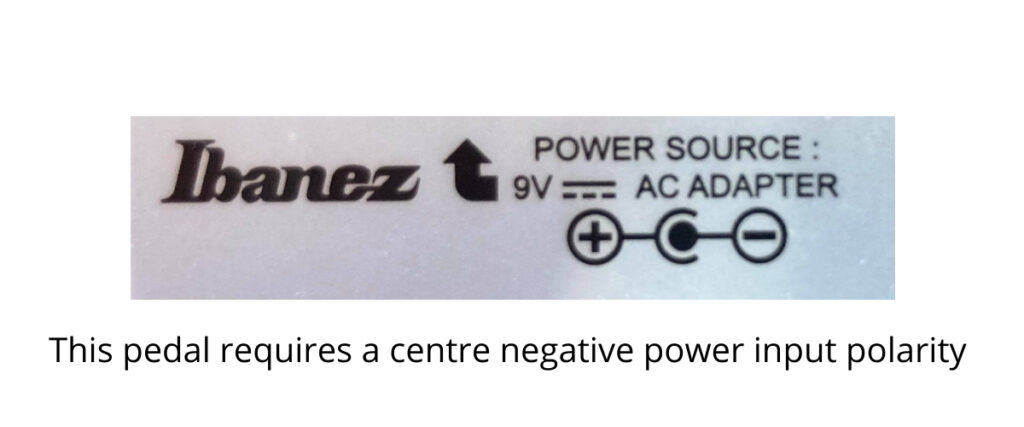
All three pieces of information will usually be located on your pedal and it’s essential you get a power supply to match them otherwise you can cause damage to the pedal or yourself. If you can’t locate the information, check the manufacturer’s website or instruction manual.
These rules apply for all three power supply options that I will be discussing in this article.
Summary of the Rules:
- Make sure the voltage of the power supply and pedal match exactly.
- Make sure the power supply has enough current to power the pedal (the power supply can have surplus current so it does not need to match it exactly, it just needs to exceed it).
- Ensure that the polarity of the power supply and pedal match exactly.
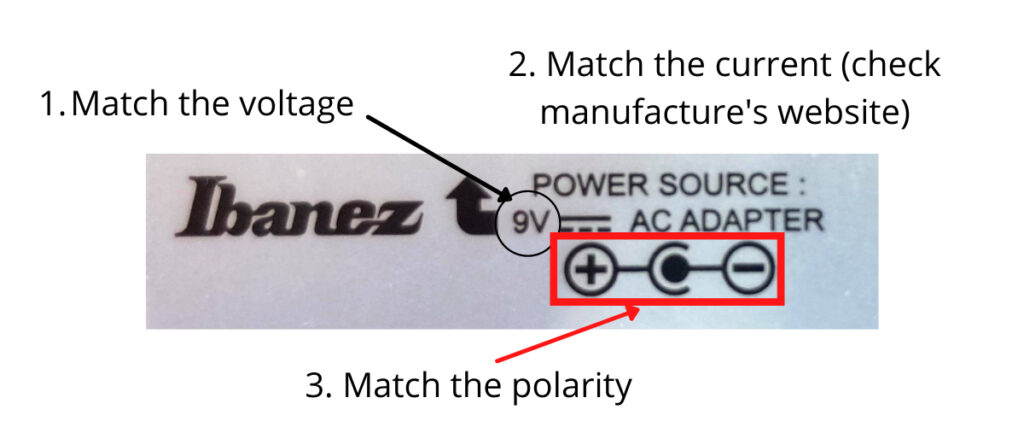
Option #1: Using Batteries
Most full-size standard guitar pedals can be powered using a single 9V DC battery which is often housed underneath the pedal. This method will not work for mini-pedals as they are much more compact so do not have room for a battery and instead must be powered using one of the other alternatives.
Advantages
- Using a battery to power a guitar pedal is the most compact method and does not require any mains connection.
- If you are using the pedal infrequently, then the battery is likely to last a long time.
Disadvantages
- This method is very expensive if you are using batteries to power multiple pedals.
- It’s not a very economical option if you are using your pedal often as you will need to keep replacing the battery (unless you choose rechargeable batteries).
- You must remember to completely unplug your pedal from the amplifier to avoid the battery draining even when it is turned off.
Check out my guide to how long guitar pedal batteries last with real-life testing.
Good For: if you have purchased your first pedal and want to get started without many extra expenses.
Bad For: powering multiple pedals and mini pedals, or if you play your guitar daily.
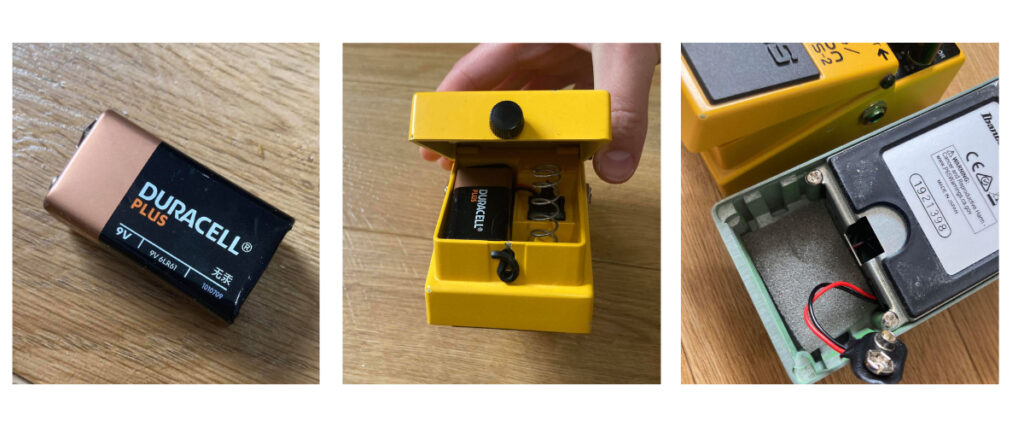
Option #2: AC Adapter and Daisy Chain
Using an AC adapter is suitable for powering pretty every type of guitar pedal. They connect the pedal to a mains supply so it can be powered without using a battery. This method works well for powering single and multiple pedals.
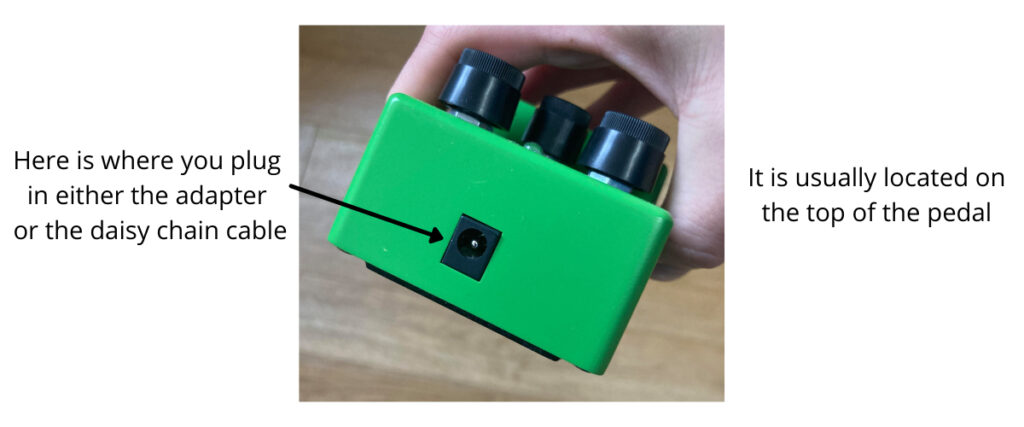
If you want to power more than one pedal, you will need a daisy chain splitter. This takes the power supply from the AC adapter and splits it between multiple pedals so they can all be powered using the same adapted.
You must make sure that it is compatible with the current and voltage of your pedals.
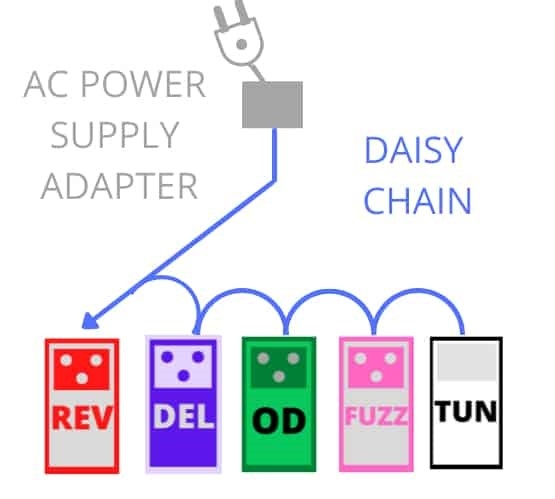
For example, if you have a 600 milliamp AC adapter and you are powering 3 pedals which all draw 100 milliamps, then you will be fine. But if you have a 500 milliamp AC adapter and try powering 6 pedals which all draw 100 milliamps each, this will not work.
To work out what current requirement your AC adapter needs to be, add up all the current requirements of all your pedals and double it (just to be on the safe side). Remember you can check the requirement on the pedal itself or the manufacturer’s website if necessary.
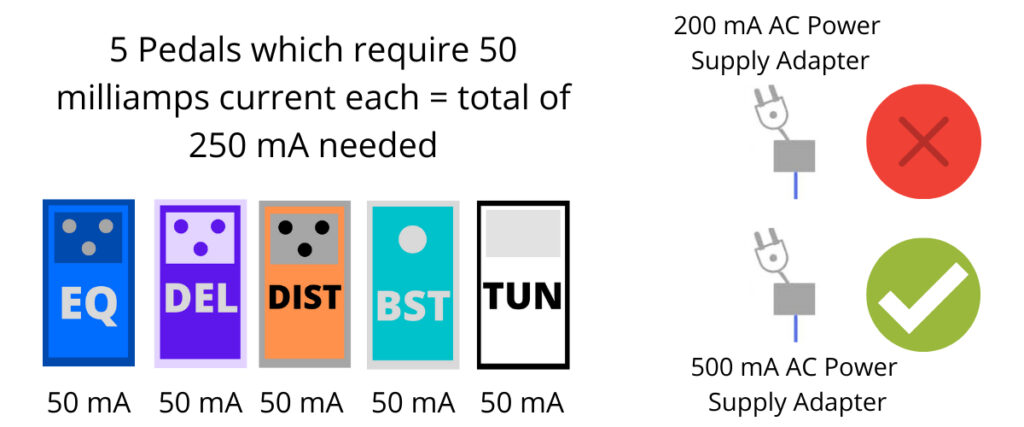
Advantages
- You never have to worry about battery life.
- This method can be used to power multiple pedals.
- Cost-effective.
Disadvantages
- Since the power supply to each pedal is not isolated, there will be more background noise (hum) compared to the alternative methods.
- The amount of cables used can cause a pedalboard to look cluttered.
Good for: powering multiple pedals cheaply.
Bad for: creating clutter (due to the amount of cables) and creating background noise.
How to use a Daisy Chain to Power Guitar Pedals
- Make sure your AC adapter can supply enough current for all your pedals (total up the current draw from each pedal to calculate this).
- Make sure your AC adapter matches the voltage and polarity of your pedals (this information will be on the pedals and adapter itself).
- Plug the daisy chain splitter into the AC adapter.
- Connect the other end of the daisy chain to your pedals.
- Plug your AC adapter into the wall and turn it on.
Here is a link to the Sovvid Guitar Pedal Power Supply on Amazon (image also links to Amazon).
Option #3: DC Power Supply
The final option of powering guitar pedals, is to use a DC power supply, also known as a power brick. There are two types of power bricks: isolated and non-isolated.
Isolated power supplies ensure that each pedal is powered individually to reduce background noise. Non-isolated power supplies result in the pedals all sharing the same earth connection, which emphasises the background humming and hissing.
With a DC power supply (isolated or non-isolated), you will need to make sure you match the current, voltage and polarity to your pedals as explained previously.
With non-isolated DC power bricks, you will need to total up the current (milliamp) requirements of each pedal and ensure that it does not exceed the current supply of the power brick. With isolated power bricks, each output will have a separate current limit so you will often get a higher overall supply and will not need to total up the requirements of each pedal.
There are multiple different sizes of DC power supplies available so you can choose one with the required number of outputs for the amount of pedals you’re using. On some power bricks, all the outputs may be compatible with the same voltage and current as each other, whereas some have multiple outputs types (example below).
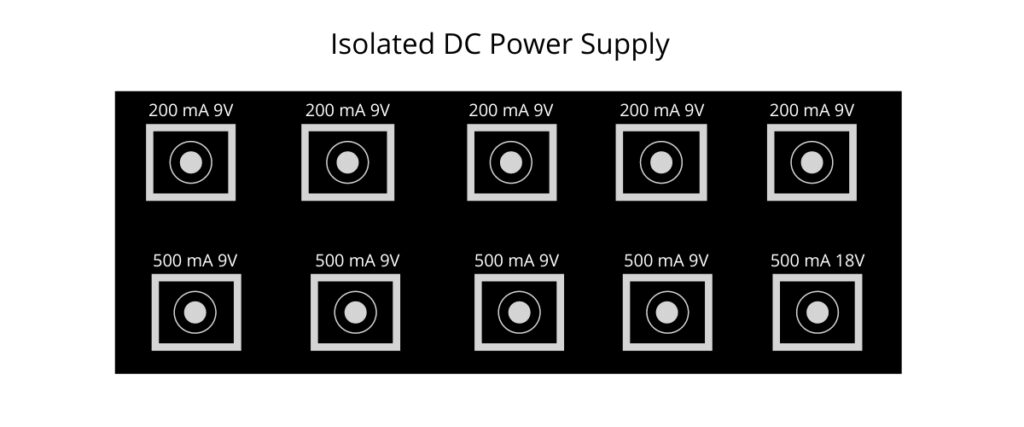
Advantages
- They often offer a higher current supply than AC adapter and daisy chain splitter methods.
- Reduced background noise (humming).
- More choice for multiple voltage outputs to power different types of pedals.
Disadvantages
- Isolated power supplies are more expensive.
- They take up more room on the pedalboard so may need to be mounted underneath it to save space.
Good For: players who are powering multiple types of pedal and want the best audio quality
Bad For: players on a tighter budget.
How to Use an Isolated DC Power Supply to Power Guitar Pedals
- Make sure the output of the power supply can supply enough current for each pedal your pedal, and match the voltage and polarity for each pedal.
- Connect your pedal to the required output on the power supply.
- Connect the power supply to the mains and turn it on.
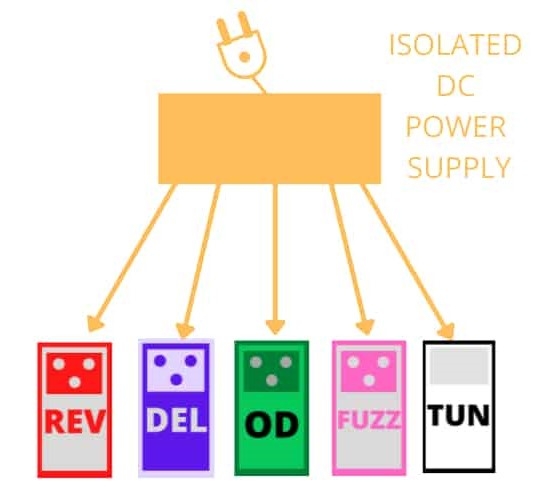
Comparing Power Supply Options
So out of the three options, which should you go for? Here are some key points:
- Using a battery to power a pedal is a cheap option that is very easy to set up. However, it can get very expensive if you use multiple pedals, and you will need to frequently replace the battery if you use the pedal often. They also do not work for mini-pedals.
- An AC adapter and daisy chain splitter is an affordable power supply option that doesn’t take too much space and is more cost-effective than using batteries for multiple pedals. However, it can lead to a background humming and hissing.
- An isolated DC power supply brick offers the best audio quality, but is the most expensive and bulkiest option. Non-isolated DC power supplies are cheaper, but still suffer from background humming and hissing.
| Cheapest for single pedals | Battery |
| Cheapest for multiple pedals | AC adapter and daisy chain |
| Best audio quality | Isolated DC power supply |
Here are some examples of types of players and which option I would recommend.
Player #1
- Only uses one pedal (not a mini pedal) and plays their guitar a few times a week for around 30 minutes per session.
- Best Option: Battery
Player #2
- Only uses one pedal (not a mini pedal) and plays their guitar every day for around an hour per session.
- Best Option: AC Adapter and daisy chain splitter.
Player #3
- Uses 3 pedals (mini and full-size mix) and plays their guitar at home and is less concerned about having perfect audio quality.
- Best Option: AC adapter and daisy chain splitter.
Player #4
- Uses at least 3 pedals at a time and plays their guitar at gigs so needs the best audio quality.
- Best Option: Isolated DC Power Supply
Best Power Supplies for Pedals
To round off the article, here are some top power supply picks to suit different requirements with links so you can check the current prices.
Sovvid Guitar Pedal Power Supply on Amazon
Most affordable option
- Type: Daisy Chain
- 4 x 9v outputs
- 2 x high voltage outputs
- 2 x variable voltage outputs
MXR M237 DC Power Brick
Affordable option to power lots of pedals
- Type: Non-isolated DC power supply
- 8 x 9V outputs and 2 x 18V outputs
Voodoo Lab Pedal Power 2 Plus
Best Audio Quality for Multiple Pedals
- Type: Isolated DC power supply
- 4 x 9v outputs
- 2 x high voltage outputs
- 2 x variable voltage outputs
Strymon Zuma
Great Audio Quality for High Current Pedals
- Type: Isolated DC power supply
- Designed for high current pedals
- 7 x 9v outputs
- 2 x variable voltage outputs
Check out my list of the 5 best effects pedals to buy first.
Frequently Asked Questions
Here are the answers to questions you might still have about powering your guitar pedals.
Is it bad to leave guitar pedals plugged in?
Guitar pedals should not be left plugged in as it can cause current surges and heat build-up which can potentially damage them. Leaving guitar pedals plugged in to an amplifier will cause the battery to drain if you are using a 9V DC battery to power them.
How long do guitar pedal batteries last?
Most 9V DC batteries last between 5-10 hours in a guitar pedal. The battery will continue to drain if it is left plugged into an amplifier, even if the guitar is not being played.
Can I use a 12V power supply on a 9V guitar pedal?
You cannot use a higher voltage power supply to power a guitar pedal which is designed to work with a lower voltage as this will damage the pedal. For example, a 9V power supply must be used for a 9V guitar pedal, using a 12V power supply would damage the pedal.
Still getting to grips with pedals? Check out my complete guide to using guitar pedals for everything you need to know.




